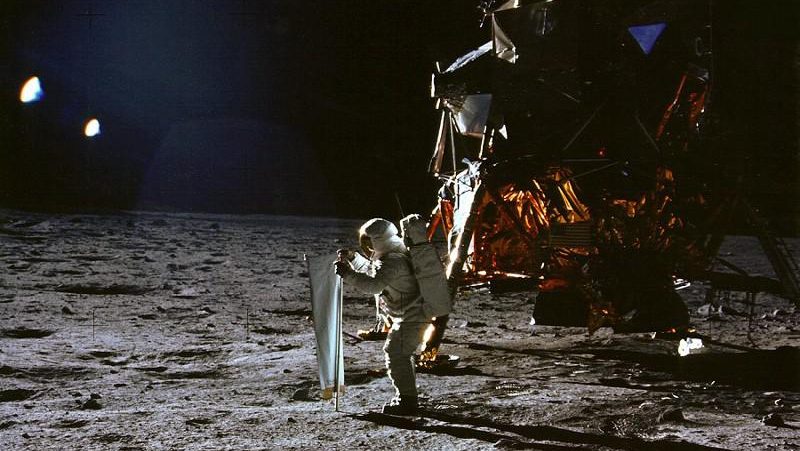Ask Ethan: Why Can’t The Large Hadron Collider Put More Energy Into Its Particles?

The highest-energy particles on Earth reach enormous energies, but it’s nothing compared to what the Universe can achieve.
Deep underground in Europe, the world’s most powerful particle accelerator lives in a circular tunnel some 27 kilometers in circumference. By evacuating all the air inside, protons moving at nearly the speed of light are circulated in opposite directions, pushed to the highest energies ever artificially created. At a few explicit points, the two internal beams are focused as tightly as possible and are made to cross, where a small number of proton-proton collisions occur with each bunch of protons that passes. And yet, the energy-per-particle tops out at about 7 TeV: less than 0.00001% the energies we observe from our highest-energy cosmic ray particles. Why are we so limited here on Earth? That’s the question of Patreon supporter Ken Blackman, who wants to know:
Why can’t the LHC create particles with the energy of the OMG particle? What’s the limitation? Why can’t such a vast, incredibly powerful machine pump a mere 51 joules into a single subatomic particle?
When you look at what we do on Earth versus what occurs in space, there’s no comparison at all.
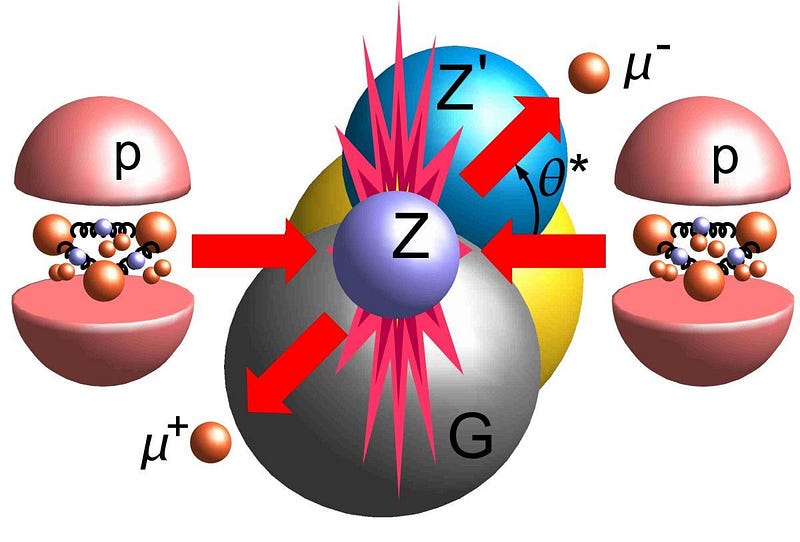
As complicated and intricate a machine as the Large Hadron Collider (LHC) actually is, the principle it works on is surprisingly simple. Protons, and electrically charged particles in general, can be accelerated by electric and magnetic fields. If you apply an electric field in the direction of a proton’s motion, that electric field will exert a positive force on that proton, causing it to accelerate and gain energy.
If it were possible to build a particle accelerator that were infinitely long, and you didn’t have to worry about any other forces or motions, this would immediately give us an ideal way to create particles of whatever high energies we were capable of dreaming up. Apply that electric field to your proton, which causes your proton to experience an electric force, and your proton accelerates. So long as that field is there, there’s no limit to how much energy you could pump into your proton.
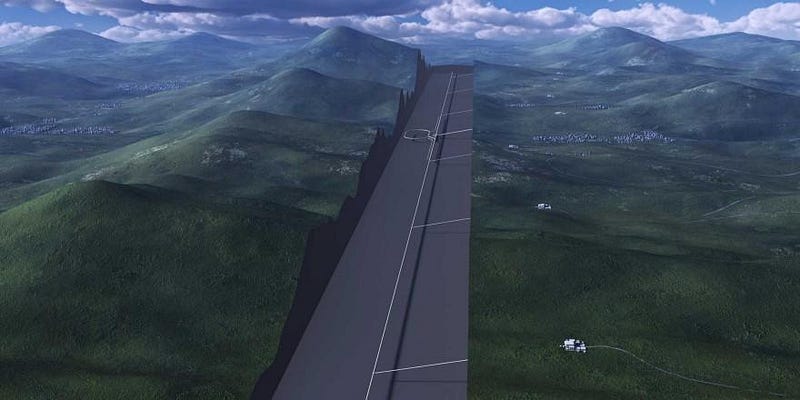
The accelerating cavities that the LHC uses are extremely efficient, and can accelerate particles by about 5 million volts for every meter that they travel through. If you wanted to pump “a mere” 51 joules into a proton, however, that would require an accelerator cavity that was an astounding 60 billion kilometers long: about 400 times the distance from the Earth to the Sun.
Although this would get you to an energy of about 320 quintillion electron-volts (eV) per particle, or about 45 million times the energy the LHC actually achieves, it’s wildly impractical to build a uniform electric field that spans such a great distance. Even building a linear particle accelerator across the longest continuous distance in the United States, close to 4,500 km, would only get you up to about 22 TeV per particle: barely better than the LHC. (And it would have to rise/sink hundreds of kilometers above/below the Earth, due to our planet’s curvature.)
This highlights why the highest-energy particle accelerators, the ones that accelerate protons, are almost never linear in configuration, but rather are bent into a circular shape.
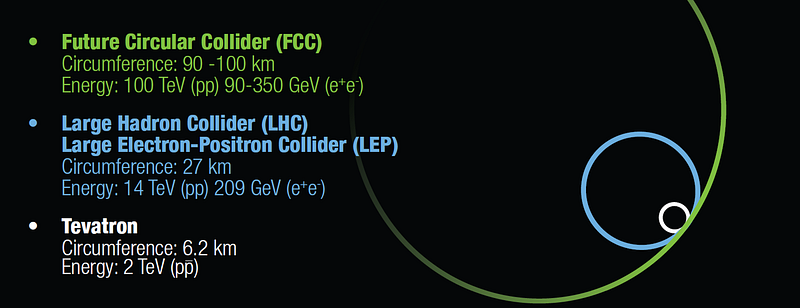
While electric fields are needed for taking your particles to higher energies and bringing them that tiny fraction-of-a-percent closer to the speed of light, magnetic fields can also accelerate charged particles by bending them into a circular or helical path. In practice, this is what makes the LHC and other accelerators like it so efficient: with just a few accelerating cavities, you can achieve enormous energies by using them repeatedly to accelerate the same protons.
The setup then seems simple. Start by accelerating your protons in some fashion before injecting them into the main ring of the LHC, where they’ll then encounter:
- straight parts, where the electric fields accelerate the protons to higher energies,
- curved parts, where magnetic fields bend them in curves until they reach the next straight part,
and repeat that until you get to as high an energy as you want.
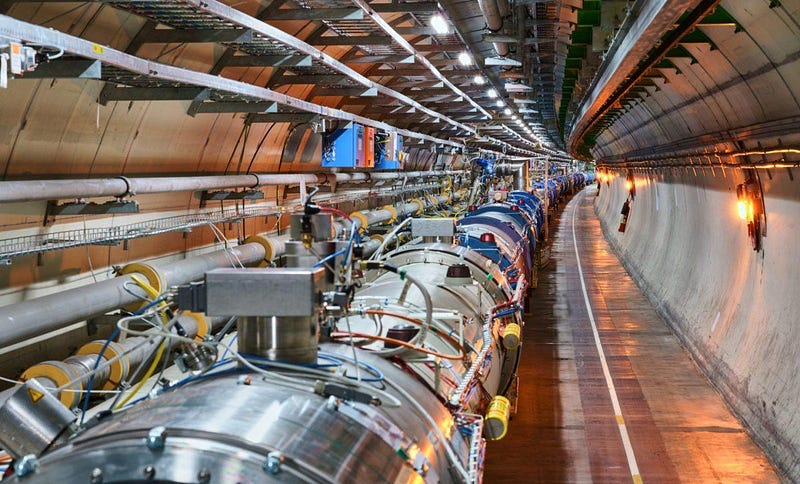
Why, then, can’t you reach arbitrarily high energies using this procedure? There are actually two reasons: the one that stops us in practice and the one that stops us in principle.
In practice, the higher the energy of your particle, the stronger the magnetic field needs to be in order to bend it. It’s the same principle that applies to driving your car: if you want to take a very tight turn, you’d better slow down. If you go too quickly, the force between your tires and the road itself will be too great, and your car will skid off the road, leading to a disaster. You either need to slow down, build a road with a larger curve, or (somehow) increase the friction between your car’s tires and the road itself.
In particle physics, it’s the same story, except your curved tunnel is the curved road, your particle’s energy is the speed, and the magnetic field is the friction.
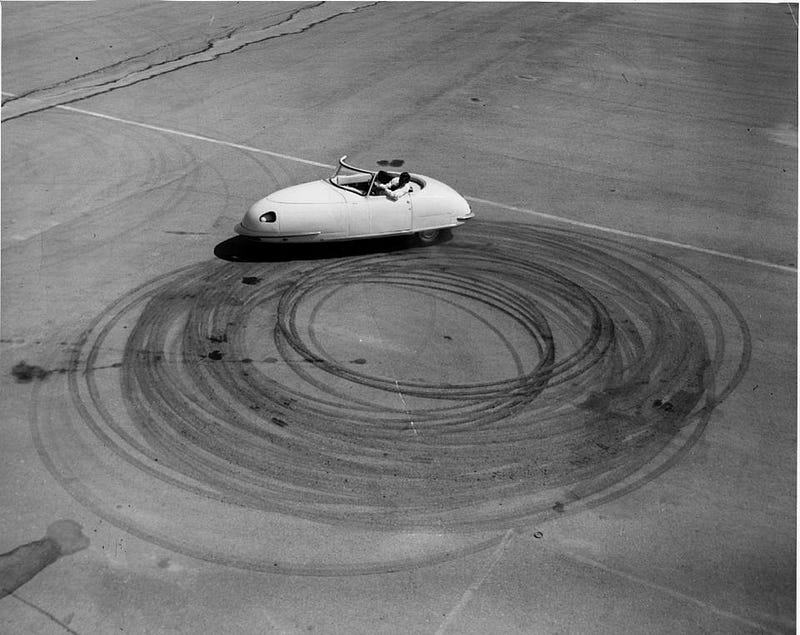
This means that the energy of your particle is inherently limited, in practice, by the size of the accelerator you’ve built (specifically, by the radius of its curvature) and the strength of the magnets that bend the particles inside. If you want to increase your particle’s energy, you can either build a larger accelerator or increase the strength of your magnets, but both of those present large practical (and financial) challenges; a new particle accelerator at the energy frontiers is now a once-per-generation investment.
Even if you could do that to your heart’s content, however, you’d still be limited in principle by another phenomenon: synchrotron radiation. When you apply a magnetic field to a moving charged particle, it emits a special type of radiation, known either as cyclotron (for low-energy particles) or synchrotron (for high-energy particles) radiation. While this has its own practical uses, such as with applications pioneered at Argonne Lab’s advanced photon source, it fundamentally further limits the speeds of particles bent by a magnetic field.
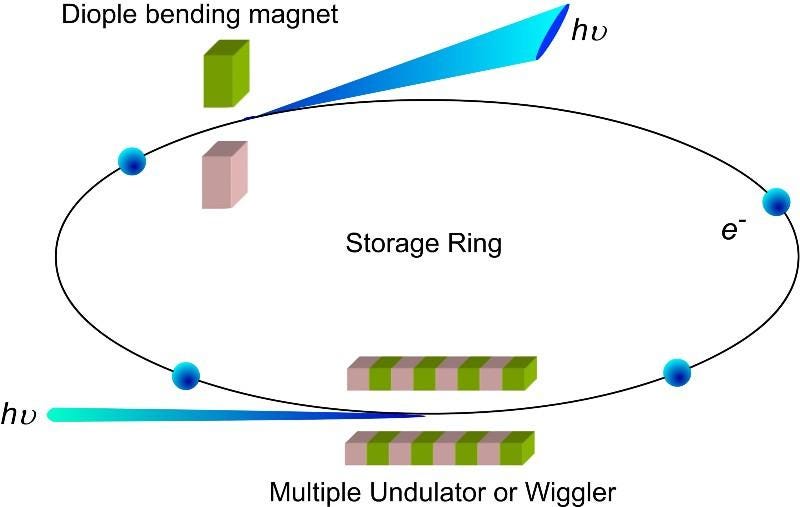
The limitations of synchrotron radiation are why, to reach the highest energies, we accelerate protons instead of electrons. You might think that electrons would be the better bet for reaching higher energies; after all, they have the same strength electric charge as a proton, but are just 1/1836th the mass, meaning the same electric force can accelerate them nearly 2,000 times as much. The amount of acceleration a particle experiences, for a given electric field, depends on the charge-to-mass ratio of the particle in question.
But the rate that energy gets radiated due to this effect depends on the charge-to-mass ratio to the fourth power, which limits the energy you can achieve very quickly. If the LHC operated with electrons rather than protons, it would only be able to reach energies of around 0.1 TeV per particle, consistent with the limits that the LHC’s predecessor, the Large Electron-Positron collider (LEP), actually ran into.
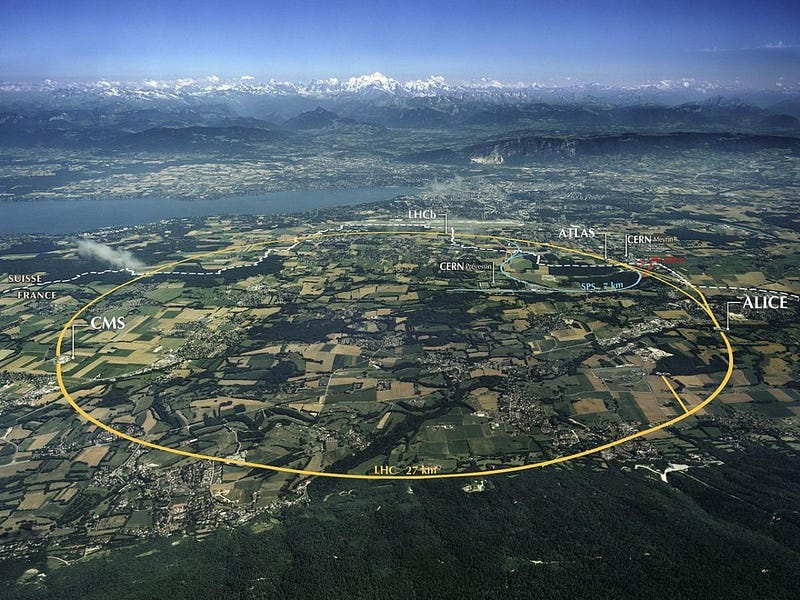
To exceed the limits of synchrotron radiation, you must build a larger particle accelerator; building a stronger magnet won’t gain you anything. Although many people are attempting to build a next-generation particle collider, leveraging both stronger electromagnets and a larger ring radius, the maximum energies people are dreaming of are still only around 100 TeV per collision: still a factor of more than a million lower than the Universe itself can produce.
The same physics that fundamentally limits the energies that particles achieve on Earth still exist in space, but the Universe provides us with conditions that no terrestrial laboratory will ever achieve. The strongest magnetic fields created on Earth, such as at the National High Magnetic Field Laboratory, can approach 100 T: a little over a million times stronger than Earth’s magnetic field. By comparison, the strongest neutron stars, known as magnetars, can generate magnetic fields of up to 100 billion T!
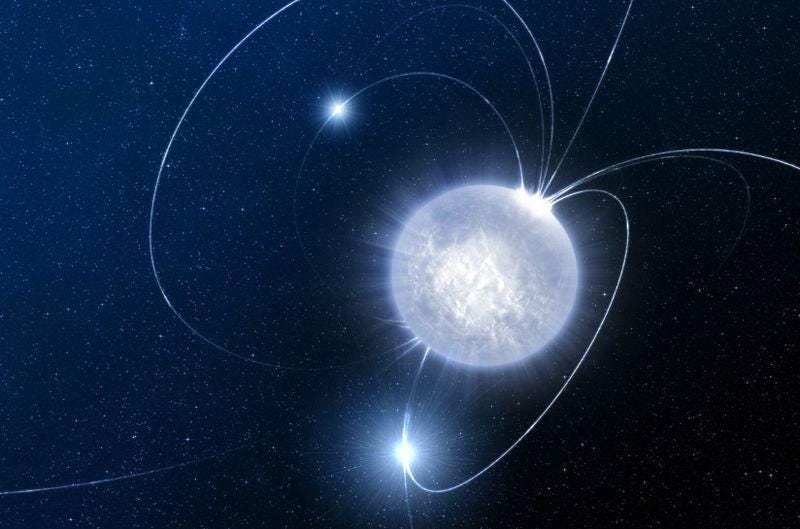
The natural laboratories found in space don’t only accelerate protons and electrons, but atomic nuclei as well. The highest energy cosmic rays we’ve ever measured very accurately aren’t simply protons, but rather are heavy nuclei like iron, which is more than 50 times as massive as a proton. The single highest energy cosmic ray of all, known colloquially as the Oh-My-God particle, was likely a heavy iron nucleus accelerated in an extreme astrophysical environment: around a neutron star or even a black hole.
The electric fields that we can generate on Earth simply cannot hold a candle to the strength of the accelerating fields found in these astrophysical environments, where more mass and energy than our entire Solar System contains is compressed into a volume about the size of a large island like Maui. Without the same energies, environments, and cosmic scales at our disposal, terrestrial physicists simply cannot compete.
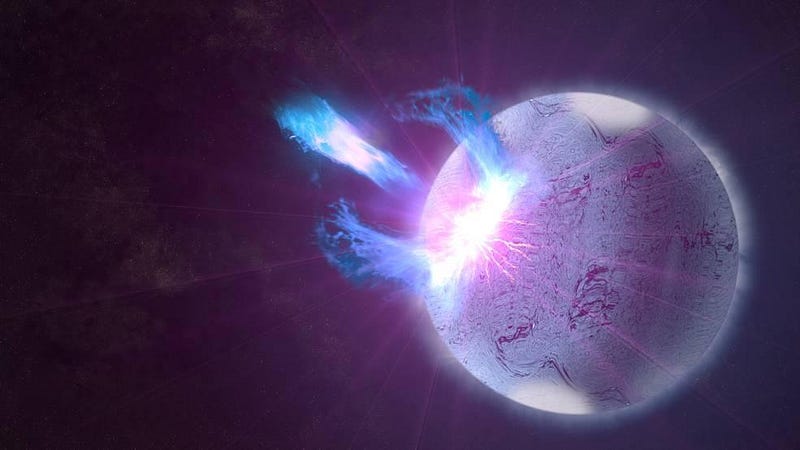
If we could scale up our particle accelerators in size, as though cost and construction were no object, we could someday hope to match what the Universe offers. With magnets comparable to what we have in the LHC today, a particle accelerator that circled Earth’s equator could reach energies some 1,500 times what the LHC could reach. One that extended to the size of the Moon’s orbit would reach energies nearly 100,000 times what the LHC achieves.
And going even farther, a circular accelerator the size of Earth’s orbit would finally create protons whose energies reached that of the Oh-My-God particle: 51 joules. If you scaled your particle accelerator all the way up to the size of the Solar System, you could theoretically probe string theory, inflation, and literally recreate Big Bang-level energies, with potentially Universe-ending consequences.
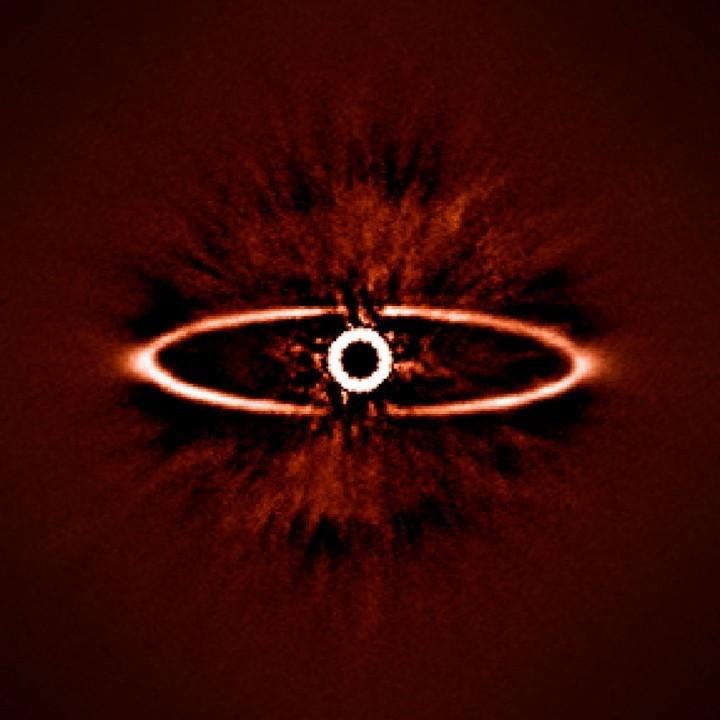
For now, perhaps unfortunately, those will have to remain the dreams of physics enthusiasts and mad scientists. In practice, particle accelerators on Earth, limited by size, magnetic field strength, and synchrotron radiation, simply cannot compete with the astrophysical lab provided by our natural Universe.
Send in your Ask Ethan questions to startswithabang at gmail dot com!
Ethan Siegel is the author of Beyond the Galaxy and Treknology. You can pre-order his third book, currently in development: the Encyclopaedia Cosmologica.



